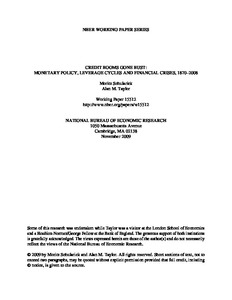Credit booms gone bust: monetary policy, leverage cycles and financial crises, 1870-2008
"The crisis of 2008-09 has focused attention on money and credit fluctuations, financial crises, and policy responses. In this paper we study the behavior of money, credit, and macroeconomic indicators over the long run based on a newly constructed historical dataset for 12 developed countries...
| Main Authors: | , |
|---|---|
| Institution: | ETUI-European Trade Union Institute |
| Format: | TEXT |
| Language: | English |
| Published: |
Cambridge, MA
2009
NBER |
| Subjects: | |
| Online Access: | https://www.labourline.org/KENTIKA-19178353124919965359-Credit-booms-gone-bust-monetar.htm |
| Summary: | "The crisis of 2008-09 has focused attention on money and credit fluctuations, financial crises, and policy responses. In this paper we study the behavior of money, credit, and macroeconomic indicators over the long run based on a newly constructed historical dataset for 12 developed countries over the years 1870- 2008, utilizing the data to study rare events associated with financial crisis episodes. We present new evidence that leverage in the financial sector has increased strongly in the second half of the twentieth century as shown by a decoupling of money and credit aggregates, and we also find a decline in safe assets on banks' balance sheets. We also show for the first time how monetary policy responses to financial crises have been more aggressive post-1945, but how despite these policies the output costs of crises have remained large. Importantly, we can also show that credit growth is a powerful predictor of financial crises, suggesting that such crises are "credit booms gone wrong" and that policymakers ignore credit at their peril. It is only with the long-run comparative data assembled for this paper that these patterns can be seen clearly." |
|---|---|
| Physical Description: | 37 p. Digital |

